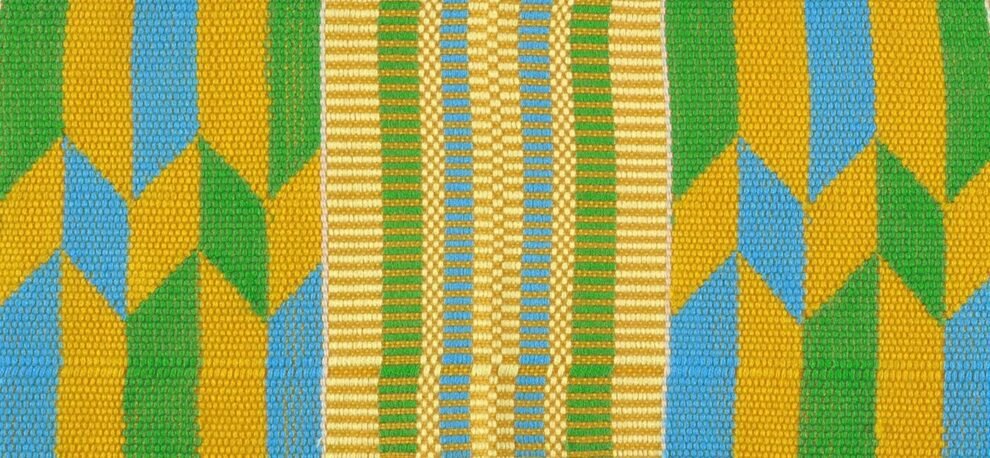Do you have a love of African textiles? Are you interested to learn more about traditional African fabrics perhaps for research purposes or a new sewing or art project? Join us on our journey to explore the luxurious and beautiful handwoven textiles produced in Africa.
In 2017, we travelled to Ghana in West Africa and during our time there we visited several talented artisans including the Kente weavers in the Ashanti Region. Inspired by the experience, this page explores everything you need to know about Kente cloth, from its history of the fabric and how it’s made, to the hidden meanings behind the fascinating designs.
History of Kente Cloth – Where did it Originate from?
Kente is no ordinary cloth and is easily recognisable worldwide. The method of producing Kente, called strip weaving, has existed in West Africa since the 11th century. In 1697, the King of the Ashanti Kingdom, Osei Tutu, selected several weavers from nearby towns and villages to travel to the neighbouring Ivory Coast to become experts in the complex art form.
Once they returned to Ghana, they started to weave the beautiful and colourful cloth exclusively for the King because Kente was originally made and worn only by royals. The weavers started to create their own unique designs, which are now well known worldwide as ‘Ashanti Kente’. The Ewe is another ethnic group that also weaves Kente in Ghana.
Today, the Ashanti royals still wear the sacred cloth usually draped across their shoulders or worn like a toga, including traditional black and white designs, for prestigious occasions including ceremonies, worship, outings, marriages and funerals.
How Kente Cloth is Made
Kente is a very time-consuming cloth to weave by hand, which is why it’s expensive and a high-value item. It’s really interesting to watch the weavers, traditionally men sat inside the wooden handlooms and see how quickly their hands move.
It takes several years for a new weaver to learn how to make Kente fabric from an experienced master weaver. Apprentices don’t usually make their own designs until they have been producing Kente for a number of years.
The Process of Weaving Kente Cloth
When you watch a Kente weaver, it’s difficult to see exactly how they control the handloom as their hands and feet move so quickly. It requires a lot of technical experience as well as good coordination and skill. We explain the interesting and complex production process so it’s clear and easy to understand.
Raw Materials & Preparation
The type of raw materials used for Kente weaving include:
- Cotton (grown in the north of Ghana)
- Silk (very expensive and was the traditional thread used)
- Rayon (synthetic fibre)
- Metallic thread (adds shine to the cloth)
Usually, the threads are hand-spun by villagers where the Kente is made as it’s cheaper than buying a ready spun cone. The traditional hand spinning method is demonstrated in this short video clip.
The dye used to change the thread colour can be made locally by grinding the bark or leaves of specific trees. Local dyes are preferred as the colours do not fade but these days the majority of dyes are imported from China or Japan.
Method of Weaving Kente
Kente cloth is purely hand woven; no machinery is used. Weavers sit inside a wooden handloom to create long narrow interwoven strips that are later sewn together by a tailor to make the traditional Kente cloths.
It can take a long time to set up a new design on a handloom, which requires a lot of experience. Weavers use both their hands and feet to operate the loom. The warp is placed quite far away from the loom under heavy stones to keep it taut, which gradually moves closer to the loom the more cloth that is produced.
The heddles (cords) separate the warp threads so the weft can be passed or thrown through using a shuttle. The warp is then beaten in evenly using the ‘beater’ to make it more compact.
The more complicated the design the more expensive it is to purchase. There are 3 kinds of weaving known locally in this village as simple, double and triple. The latter is the most complicated as the designs can take 4-5 hours for an experienced weaver to make just one strip!
If you prefer, you can draw your own design and the weavers can replicate it for you. When President Obama visited Ghana, the weavers made a special design for him in his honour. If a local person does a good deed in their community, they can also name a new design after them.
What Kente Cloth Means
There are hundreds of different Kente pattern designs in existence, some are more well known and sought after than others. Each fabric design has its own name and the bold patterns and vibrant colours have hidden meanings, symbols and stories to tell. Like Kanga cloth, Kente fabric can be used as a non-verbal way of communication.
Hidden Meanings Behind Kente Cloth Patterns
The Kente cloth designs are powerful cultural symbols that represent history and philosophy. Each design has a specific name and significant meaning that reflects the cultural values of Ghanaians as well as historical events. You can tell the symbolic meanings from the different designs and colours used.
Examples of meanings behind the designs:
1. Fatima Nkrumah
Kwame Nkrumah was the first President of Ghana after independence from Britain in 1957. The First Lady, Fatima Nkrumah, was Egyptian and he married her for unity. This design was named after her and symbolises the avoidance of racism and discrimination.
2. Zig-Zag
Life is not a smooth journey; there may be many obstacles in the way.
3. Mako Maso Adeae (My Heart’s Desire)
Conveys the non-verbal message of ‘I love you’ to a lady by leaving it at her front door.
Other designs convey meanings of good health, wealth, strength etc.
Hidden Meanings Behind Kente Cloth Colours
Yellow – royalty, wealth, beauty
Green – fertility, vegetation, forest, new harvest
Red – blood of ancestors, political, death
Blue – peace, harmony, love
Pink – love, happiness
Orange – wealth, joy
Gold – royalty, wealth, high status
Silver – joy, purity
Black – heritage, strength, spirituality
White – purity, festive
Grey – healing
What Kente Fabric Can be Used for
Authentic Kente and printed imitation fabrics are versatile, beautiful fabrics that be used for a range of different things. They can be used to make clothing, accessories and decorative items for the home. There are lots of options when it comes to experimenting with Kente fabric.
Modern African Print Clothing
In Ghana today, the cloth can be purchased and worn by local people. Kente outfits are very popular to wear especially at weddings and special occasions. Akans, from the Ashanti kingdom, traditionally wear clothes made from Kente cloth as it’s a source of great pride for many Ghanaians and the Diaspora. Authentic Kente is a status symbol of wealth and identity as it is a luxurious and expensive fabric.
Every new Kente design is registered and copyrighted for protection however, fabric manufacturers in Ghana and China, for example, are replicating the designs using industrial printing machines. These imitation fabrics known as ‘Kente Print’ are much cheaper.
The increased popularity and wide availability of printed Kente fabrics have encouraged young, aspiring fashion designers to experiment with modern African print clothing designs. See how the fabric can be made into gorgeous, unique garments by browsing African inspired clothing.
African Inspired Homeware
As well as Ghanaian clothing fashion, Kente is also used to make homeware such as blankets, throws, cushion covers, bedding, aprons, lampshades, table cloths and placemats. Learn how easy it is to introduce African interior design into your home.
We recommend adding small touches of African inspired décor fused with simple, modern design elements. African print fabric can help to add colour and texture to a room to create interest and a warm, cosy feel.
If you’re interested to learn more about African fabrics and textiles, including Mud Cloth, Aso-oke, Adire, Akwete, Kanga, Kikoy and Ankara fabrics, explore our blog about the best African fabrics for home interior design.
Difference Between Kente Cloth & African Print Fabric
Kente cloth originates from West Africa whereas African print fabric (commonly known as ‘Ankara’ in West Africa and ‘Kitenge’ or ‘Chitenge’ in East Africa) was first produced in Indonesia. There is a great difference in the way that these two fabrics are made.
African wax print fabric is 100% cotton cloth that is industrially produced in large-scale factories using a wax-resist dyeing technique. The fabric designs and colours look the same on both sides of the cloth. Ankara fabric is usually purchased in lengths of 6 or 12 yards.
Their designs are created on a computer in black and white. The pattern is engraved onto a pair of copper rollers which prints melted, molten wax onto grey fabric. The fabric is put inside an indigo dye bath where the dye repels the areas covered by wax.
A special machine can be used to crack the wax to create different effects such as marbling and bubbles. Printing machines add two to three colours to the cloth (block printing by hand may also be used). The cloth is washed to remove the wax before any finishes are applied.
It’s more difficult to source authentic Kente cloth than readily available African print fabric that is produced in several countries in Africa, Europe and Asia.
Get in Touch
We hope you have enjoyed reading about Kente. If you’d like any more information, then please get in touch and we can help answer any questions. Alternatively, learn more about Ankara/Kitenge fabric by reading our blog on the story behind the fabric.
Source: Kitenge











